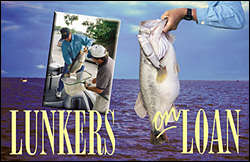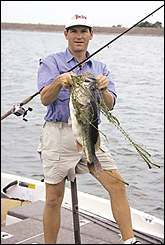|

TPWD's ShareLunker program, despite controversy and
setbacks over the years, is back on track in -literally- a big,
big way.
By Paul A. Cañada
My first memories of the
Texas Parks & Wildlife Department's ShareLunker program center
around Barry St. Clair's state record fish. I took my oldest boy
to see her at Irving Marine where she was on display in a simple
tank. I remember looking at that 18.18-pound leviathan and thinking
"There's something mysterious and unsettling about her."
I developed a healthy
respect for the bass and visited her many times before they moved
her to the Dallas Aquarium, where she eventually died. In sharing
his record-breaking fish, St. Clair gave all anglers an opportunity
to experience some of the wonder and excitement felt when he first
caught a glimpse of her.
St. Clair's donation
was a wonderful gift to the people of Texas.
The Klondike, Texas,
angler's contribution continued to fuel the excitement surrounding
the ShareLunker program and the growing catch and release
ethic. Many anglers-after seeing the ShareLunker display at boat
and tackle shows across the state-would make it their angling
goal to be a contributor to the program. Others would see the
replicas of other famous contributions and decide that indeed,
fiberglass replicas-rather than skin mounts-were the way to go.
Mortal Combat

According to Lake Fork guide Dennis States, one of the reasons for the ShareLunker program was to encourage anglers to release big fish, ensuring the future of Texas' big-bass lakes. Spawning is a secondary benefit, but shouldn't be a primary purpose. He argues that many of the big fish are very old and susceptible to stress.
|
Still, many conservationists
wonder: As much as the ShareLunker program has meant to Texas
bass fishing, why has it been the center of so much controversy
over the last 3 or 4 years? We need only look to the mortality
rate of fish that were entered into the program to find the fuel
that stoked the fires of controversy. Between November 1986 and
April 1998, 99 of the program's 281 entries died while in the
ShareLunker program's care.
Respected Lake Fork guide
Larry Barnes was the ramrod behind the protest.
"Most of the full-time
guides on Fork were aware of the high mortality rate," he
explains. "Finally, a number of us decided to stop turning
fish over to the program and encouraged others to stop sharing
fish."
Many of the guides-including
Barnes-wrote articles in regional publications, informing the
public about the high mortality rate and encouraging them to stop
contributing to the ShareLunker program.
According to Neil Ward,
the ShareLunker program coordinator, the protest succeeded in
cutting the total number of entries in half. Between 1989 and
1995, the program averaged approximately 30 entries. However,
the numbers for the last two seasons, 1996-97 and 1997-98, dropped
to 16 and 15 respectively.
"Some of the guides
put a lot of pressure on their clients and peers, encouraging
them not to contribute," explains Ward. "They didn't
feel Fork could afford to lose any more fish to our program. I
think part of the problem was that the public didn't know how
many fish were dying in the program."
continued
page 1 / page 2
| 




